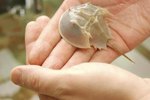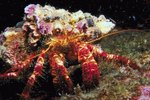
Jointed limbs are a key adaptation in the evolutionary story of the arthropod phylum, of which crustaceans are a member. Without the ability to bend their appendages, hard-bodied animals such as crustaceans would have been rendered immobile. Key to this ability to bend their limbs is the tendon, a piece of connective tissue connecting muscle to bone.
From the Brain
The crustacean’s brain controls all of its movement, although not all movement is voluntary. The brain, located in the head of the crustacean, is connected to the rest of the body via the nervous system. Depending on the animal, the nervous system either branches out from the brain to the rest of the body or stems from the brain to other nerve junctions located in the esophagus, as is the case with the fairy shrimp. Stemming from the brain and, where applicable, nerve junctions, the nervous system connects to the tendons by thin nerve fibers. Messages from the brain are carried along these fibers to the tendons, where they tell the tendon what to do.
Flexors and Depressors
Crustacean tendons have one of two functions; to flex and to depress. These functions are analogous with clenching and relaxing. When a crustacean walks, for example, the flexor tendon moves the leg muscle so it lifts, then the depressor returns the joint to the original position.
Exoskeletal Anchor
Crustaceans are defined by their hard shell, or crust. This forms an exoskeleton, which is effectively the body’s support structure. Unlike mammals, reptiles or fish, the support structure is located on the outside of the body. This provides a unique challenge for the tendons, as they are required to operate the external bone, which is located on the outside of the body. Crustacea achieve bone movement through exoskeletal anchoring, which sees the tendon link to the inside of the exoskeleton in order to move it.
Autonomy of Movement
The exoskeleton is pressure sensitive. Even when detached from the body, a crustacean limb may move if touched. This is because the shell contains cuticular stress-detection organs that automatically cause the tendon to move if local pressure is applied. The function of this autonomy enables crustaceans to automatically flinch if touched. Some flinch only when the pressure is relieved.
References
- Berkeley University: Understanding Evolution; Crustaceans: Exploiting Evolutionary Opportunity
- Encylopaedia Britannica: Crustacean Appendages
- University of Oregon: Muscle Fibers and Efferent Nerves in a Crustcean Receptor Muscle (page 552)
- Pub Med: Exoskeleton Anchoring to Tendon Cells and Muscles in Molting Isopod Crustaceans
- Springer Link: Stress Detection at the Autonomy Plane in Decapod Crustacea
Photo Credits
-
Jeffrey Hamilton/Photodisc/Getty Images
Writer Bio
Simon Foden has been a freelance writer and editor since 1999. He began his writing career after graduating with a Bachelors of Arts degree in music from Salford University. He has contributed to and written for various magazines including "K9 Magazine" and "Pet Friendly Magazine." He has also written for Dogmagazine.net.




